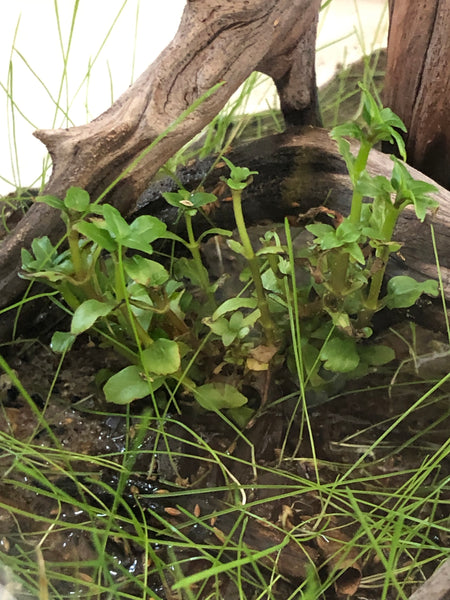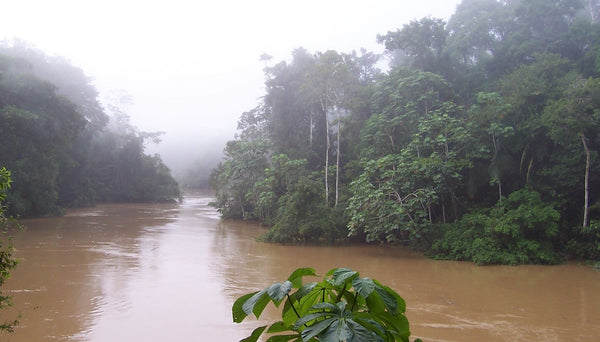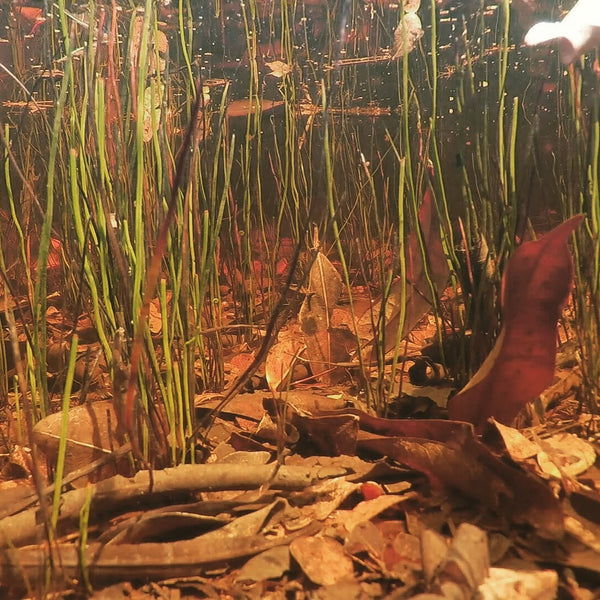- Continue Shopping
- Your Cart is Empty
Wading into the "Urban Igapo..."
As you undoubtedly know by now, we've been playing with the "365 Dynamic" approach to aquariums with our "Urban Igapo" idea.
I suppose that, on the surface, it's hardly an earth-shattering approach: You set up an aquarium. You don't fill it immediately. Rather, you grow some terrestrials plants and grasses, allow them to take hold...then you bring on the "rainy season" and flood it. After a few months, you begin drawing down the water significantly, ultimately returning it to its "dry" state again.
Repeat as desired.

Perhaps its time to loosen the chains of "conventional aquarium practice" and look towards some largely unexplored waters, right? Could there be something to be gained by modeling our aquariums after natural habitats during different times of the year? Some benefits for our fishes and the other organisms we want to nurture in our closed aquatic systems?
I just think that it would be kind of cool to model our aquariums after typical environments as they look and function at different times of the year. We've already touched on the flooded Igapo forests of Brazil, in which the forest floor becomes seasonally inundated by overflowing streams and rivers. It's an amazingly dynamic habitat that I'm glad we're starting to see more interest in.
Yet, I wondered for years how interesting it would be to take it even further, and create an aquarium around the seasonal changes in such a habitat. You know, with more shallow water levels, a greater ratio of botanicals/substrate to water, and different temperatures, lighting, etc.?
That was the basis of my "urban igapo" idea- starting out with a dry, "terrestrial" habitat and gradually flooding it to simulate the seasonal inundations which these habitats go through annually. I've done this whole cycle now something like 14 times in 3 different aquariums, nuancing various aspects like soil composition, planting, and fish stocking along the way.
It's become one of my fave projects, and I hope to see many of you playing with the idea, too!

I think that it's not only simply an enjoyable "hobby within a hobby"- it's a dynamic that we can can and should learn more about. When we flood and desiccate an aquarium, attempting to replicate this cycle, we have to learn to manage a number of different dynamics, ranging from varying levels of nutrients, to nitrogen cycle management, to stocking with fishes.
The seasonal dynamic is broad-reaching and multi-faceted in the aquarium, as it is in Nature.
Seasonal change is hugely impactful in tropical regions.
The wet season in The Amazon runs from November to June. And it rains almost every day. And what's really interesting is that the surrounding Amazon rain forest is estimated by some scientists to create as much as 50% of its own precipitation! Think about THAT for a minute. It does this via the humidity present in the forest itself, from the water vapor present on plant leaves- which contributes to the formation of rain clouds.

Yeah, trees in the Amazon release enough moisture through photosynthesis to create low-level clouds and literally generate rain, according to a recent study published in the Proceedings of the National Academy of Sciences (U.S.)!
That's crazy.
But it makes a lot of sense, right?
Yet another reason why we need to protect these precious habitats. When you cut down a tree in the Amazon- you're literally reducing the amount of rain that can be produced.
It's that simple.
That's really important. It's more than just a cool "cocktail party sound bite."
So what happens to the (aquatic) environment in which our fishes live in when it rains? What does the rain actually do?

Well, for one thing, rain performs the dual function of diluting organics, while transporting more nutrient and materials across the ecosystem. What happens in many of the regions of Amazonia, for example- is the evolution of our most compelling environmental niches. The water levels in the rivers rise significantly. often several meters, and the once dry forest floor fills with water from the torrential rain and overflowing rivers and streams.
The Igapos are formed.
Flooded forest floors.
The formerly terrestrial environment is now transformed into an earthy, twisted, incredibly rich aquatic habitat, which fishes have evolved over eons to live in and utilize for food, protection, and spawning areas.

All of the botanical material-shrubs, grasses, fallen leaves, branches, seed pods, and such, is suddenly submerged; often, currents re-distribute the leaves and seed pods and branches into little pockets and "stands", affecting the (now underwater) "topography" of the landscape.

Leaves begin to accumulate.
Soils dissolve their chemical constituents- tannins, and humic acids- into the water, enriching it. Fungi and micororganisms begin to feed on and break down the materials. Biofilms form, crustaceans multiply rapidly. Some robust varieties grasses hang on for extended periods of time during this inundation.
Others go into a sort of "dormant" phase, "browning out" and awaiting the time when the waters will recede and once again turn the igapo into a terrestrial forest floor.

In this rich, highly dynamic environment, the fishes are able to find new food sources; new hiding places..new areas to spawn.
Life simply flourishes.
Each time I flood my "Urban Igapo" systems, I am utterly fascinated by how life manages to "sort it out" to not only "make it though", but to thrive. It's really cool to see the many microorganisms swimming around in the aquarium, obviously feeding among the submerged grasses and other materials.

Now, of course, I'll be the first to tell you that what you get out of this process is not what I"d ever label as a "conventional" aquarium system. Because of the high level of nutrients, dense growth of terrestrial grasses/plants, and rich terrestrial soil, it's certainly not a "recipe" for an aquascaping contest winner!
And yeah- it's not intended to be. This is not just about cool, "Instagram-ready" aesthetics. Sure, these "Urban Igapo" systems look very cool! (And, yeah, they're pretty damn sharable on social media- I'll give you that much...). However, it's much more than that. The focus here is on studying the function and dynamics of this unique environment in the aquarium.
If you're only looking for perfect, static aesthetics, you're bound to ultimately be disappointed, because- just like in Nature- the terrestrial plants will ultimately slip into a "dormant" phase, where they aren't all "crisp and green." They become stringy, limp, and brown over time. That being said, I personally find this "look" kind of cool...I think that you might, too, when this is considered in context.

Now, again, this is easily confused with, and I supposed comparable to a "dry start" planted aquarium or the "Walstad method" on a superficial level. However, remember that we are talking about terrestrial plants and grasses, as well as soils without any kind of "sand cap."

Sure, you can utilize some emergent-tolerant aquatic plants in your "Urban Igapo"- I've done this a few times with great success, and the added benefit that they typically look as good in the "terrestrial" phase as they do in the "aquatic" phase.

Of course, you could also use riparian-type plants, like Sedges and such, which can tolerate- or even require immersion and very moist soils for long-term health and growth. Some species of these plants are indeed found in such temporal environments in Nature, so it goes without saying that you should experiment with them in the aquarium, too!

Now, sure, playing with this type of setup brings together hobbyists fro ma number of disciplines- vivarium/terrarium people, aquarists, planted tank enthusiasts, botanical-style aquarium lovers (that's US!), etc. Now, sure, each party will have their own unique "take" on this process, as well as accompanying criticisms of the process and management.
However, "putting it all together" is really a fun process!

All sorts of fun variations are possible. Remember, it's not about trying to please some contest judge with an absolutely perfect biotopic representation, or a "ratio-compliant" aquascape.
Nope.
It's about experimentation; studying, observing, and replicating a natural process in the aquarium...to the best of our capabilities. "Artistic liberties" are not only possible- they're welcome! So many iterations, interpretations, and experiments are possible here.

And of course, it's not just about these Amazonian habitats...there are numerous other habitats around the world that are suitable for such simulations.
What about a vernal pool in Africa that houses annual killifish?
Could lowering the water level significantly at various times of the year perhaps trigger specific behaviors related to the onset of the dry season? We already have a good handle on the spawning of annual fishes like Nothobranchius, and how CO2 and such affects egg viability, development, and hatching times ( a concept known as "diapause"), but I wonder if we could gain even more insight into the fishes themselves by gradually decreasing water levels to simulate this seasonal change?
Or perhaps even changing food sources to simulate the varying resources which are available during different seasons?

I've personally played with a group of South American annual killies (Notholebias minimus "Campo Grande") in one of my recent "Varzea" versions ( a different soil "formulation" than I use in the Igapo representation...), and I've had them spawn like crazy, and the tank is currently In its "dry season phase", allowing the eggs too incubate in the soil. The idea being, of course, that the eggs will hatch and the resulting fry can be raised in the "inundated" habitat.

There are many fishes which could benefit from such replications! Lots of possibilities.
I've also played with a "Pantanal-type" simulation, in which I used a mix of terrestrial grasses, weeds, and even some dead pieces of roots to recreate the look, richness, and the function of this unique habitat. It's an altogether "unconventional" aesthetic, and a most counter-intuitive aquarium, rich, sediment-laden, tinted and turbid. A relatively high-nutrient tank...One in which the fishes utterly thrived, however!

Yes, the "Urban Igapo" idea is one which we can all play with- on many different levels. There is so much to learn, and all sorts of fun experiments to do!
Now, the number one question we are asked is when we will be releasing the "Urban Igapo" NatureBase soils that we play with for sale. The answer is very, very soon! We will be releasing these soils in "small batches", not unlike the way gourmet coffee roasters do. We won't have each "formulation" available in huge quantities immediately.
There are several reasons.

First, it's literally "hand mixed" at the present time, and it's a bit of a tedious process for us! In addition, the soils are not intended (at least in the initial phases) to be used in large aquariums. We are deliberately going to be offering relatively small packages of the materials in order for hobbyists to use them in "nano-sized" aquairums.
The reason being that the dynamic is easier to recreate and manage in such smaller systems. Also, smaller batches and package sizes will give the largest number of hobbyists to play with this stuff in the initial phases!

There will be three different "NatureBase" formulations initially- Igapo, Varzea, and Mangal (brackish!). Each will be different in formulation and appearance. Each "recipe" has been tested and used here for some time with greta results. Each one can still be refined significantly, based on your feedback!
That's part of the fun of this...A sort of "open source" project/product that we can all have some input on! It won't be perfect.
However, It will be cool.

Eventually, if they prove popular, we will market larger quantities and sizes of the soils for larger tanks.We will also have additional "additives", like special mixes of crushed botanicals/leaves, grass seeds, etc. Initially, though, we want to see you experiment, iterate, innovate, and share your ideas, iterations, successes and yeah- failures- with the community.

We understand that not everyone will do the same thing, and not everyone will have great results! In fact, I wouldn't be surprised if some of you simply make a mess...
And that's okay, too! It's a big experiment! We not only welcome- but encourage input, constructive criticism, and suggestions to improve these products!

Oh, don't forget that it's okay to make a little mess sometimes. Beautiful things can come from it.
The ongoing experimentation, the mental shifts that we've asked you to make, the "norms" of botanical-style aquarium "practice" that we've pushed here for a few years- all will come together to make the "Urban Igapo" experiment unique and enjoyable to a wide variety of hobbyists!
Stay tuned. Won't be long now!
Stay excited. Stay brave. Stay curious. Stay creative. Stay innovative. Stay patient...
And Stay Wet.
Scott Fellman
Tannin Aquatics










Scott Fellman
Author